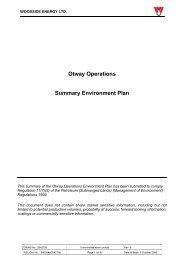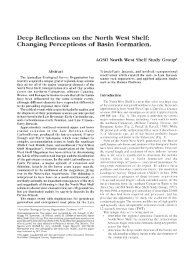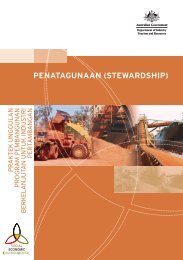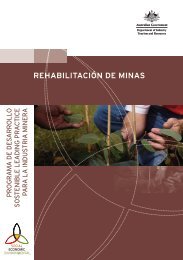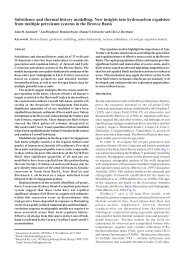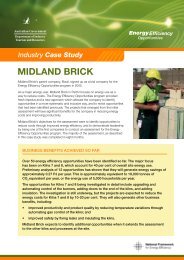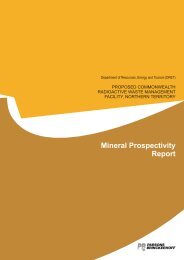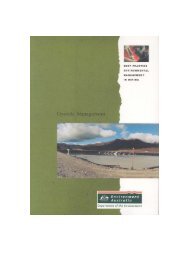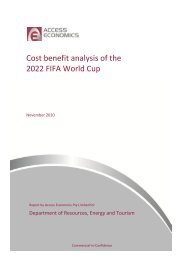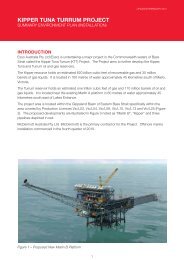A guide to leading practice sustainable development in mining
A guide to leading practice sustainable development in mining
A guide to leading practice sustainable development in mining
You also want an ePaper? Increase the reach of your titles
YUMPU automatically turns print PDFs into web optimized ePapers that Google loves.
Geochemical assessment aims <strong>to</strong> identify the distribution and variability of key<br />
geochemical parameters (such as sulfur content, acid neutralis<strong>in</strong>g capacity and<br />
elemental composition) and acid generat<strong>in</strong>g and element leach<strong>in</strong>g characteristics. A<br />
basic screen<strong>in</strong>g level <strong>in</strong>vestigation is essential and should commence at the earliest<br />
possible stage. The need and scope for detailed <strong>in</strong>vestigations will depend on<br />
the f<strong>in</strong>d<strong>in</strong>gs of <strong>in</strong>itial screen<strong>in</strong>g. S<strong>in</strong>ce some studies such as leach tests or sulfide<br />
oxidation rate measurements require a long time frame <strong>to</strong> provide the necessary<br />
data, it is important <strong>to</strong> <strong>in</strong>itiate this work well ahead of key project miles<strong>to</strong>nes.<br />
Reference <strong>to</strong> other m<strong>in</strong><strong>in</strong>g operations <strong>in</strong> the region, particularly those situated <strong>in</strong> the<br />
same stratigraphic or geological units may provide empirical <strong>in</strong>formation on the likely<br />
geochemical nature of similar ore types and host and country rocks. The P<strong>in</strong>e Creek<br />
Geosyncl<strong>in</strong>e <strong>in</strong> the far north of Australia is renowned for its propensity for acid m<strong>in</strong>e<br />
dra<strong>in</strong>age potential <strong>in</strong> virtually all gold m<strong>in</strong>es that operated <strong>in</strong> the 1970s and 80s.<br />
Early <strong>in</strong>dications can also be provided by exploration drill core where it is <strong>lead<strong>in</strong>g</strong><br />
<strong>practice</strong> <strong>to</strong> log key <strong>in</strong>dica<strong>to</strong>rs such as sulfide and carbonate type, abundance<br />
and mode of occurrence. All samples should be analysed for <strong>to</strong>tal sulfur content<br />
as a m<strong>in</strong>imum, and <strong>in</strong>clude key environmental elements <strong>in</strong> all drill core assays.<br />
M<strong>in</strong>eralogical <strong>in</strong>vestigations should exam<strong>in</strong>e the type and mode of occurrence of<br />
sulfide and carbonate m<strong>in</strong>erals.<br />
A number of procedures have been developed <strong>to</strong> assess the acid form<strong>in</strong>g<br />
characteristics and metal leach<strong>in</strong>g behaviour of m<strong>in</strong>e materials. The most<br />
widely used screen<strong>in</strong>g method is based on the Acid Base Account (ABA) which<br />
is a theoretical balance between the potential for a sample <strong>to</strong> generate acid and<br />
neutralise acid. The simplest form of the ABA is known as the Net Acid Produc<strong>in</strong>g<br />
Potential (NAPP).<br />
Some sulfur m<strong>in</strong>erals do not generate acid (but may contribute <strong>to</strong> metalliferous<br />
dra<strong>in</strong>age), and there are different forms and reactivities of AMD generat<strong>in</strong>g m<strong>in</strong>erals<br />
and AMD neutralis<strong>in</strong>g m<strong>in</strong>erals. As a result, there is a level of <strong>in</strong>herent uncerta<strong>in</strong>ty <strong>in</strong><br />
prediction based solely on the theoretical ABA. M<strong>in</strong>eralogical <strong>in</strong>vestigations, elemental<br />
analysis, sulfur and carbonate speciation, acid neutralis<strong>in</strong>g capacity, reactivity, and the<br />
Net Acid Generation (NAG) test (a rapid direct oxidation procedure) are used <strong>to</strong> address<br />
this uncerta<strong>in</strong>ty. AMD prediction is greatly enhanced by us<strong>in</strong>g a comb<strong>in</strong>ation of tests,<br />
<strong>in</strong> particular <strong>in</strong>dependent tests such as NAPP and NAG.<br />
Sampl<strong>in</strong>g<br />
Sample selection is a critical task and must be given careful consideration at all<br />
stages of a project. Samples should represent each geological material that will<br />
be m<strong>in</strong>ed or exposed and each waste type, for current and projected m<strong>in</strong>e plans.<br />
Sampl<strong>in</strong>g design normally utilises drill hole cross-sections through the deposit.<br />
The number and type of samples will be site-specific and will depend on the phase of<br />
project <strong>development</strong>, but must be sufficient <strong>to</strong> adequately represent the variability/<br />
heterogeneity with<strong>in</strong> each geological unit and waste type. Fac<strong>to</strong>rs such as gra<strong>in</strong>size,<br />
structural defects, alteration, brecciation, ve<strong>in</strong><strong>in</strong>g, etc., must therefore be considered<br />
<strong>in</strong> sample selection. As a m<strong>in</strong>imum requirement, through the exploration phase <strong>to</strong><br />
f<strong>in</strong>al feasibility, all drill hole samples should be assayed for <strong>to</strong>tal sulfur.<br />
A GUIDE TO LEADING PRACTICE SUSTAINABLE DEVELOPMENT IN MINING 47






